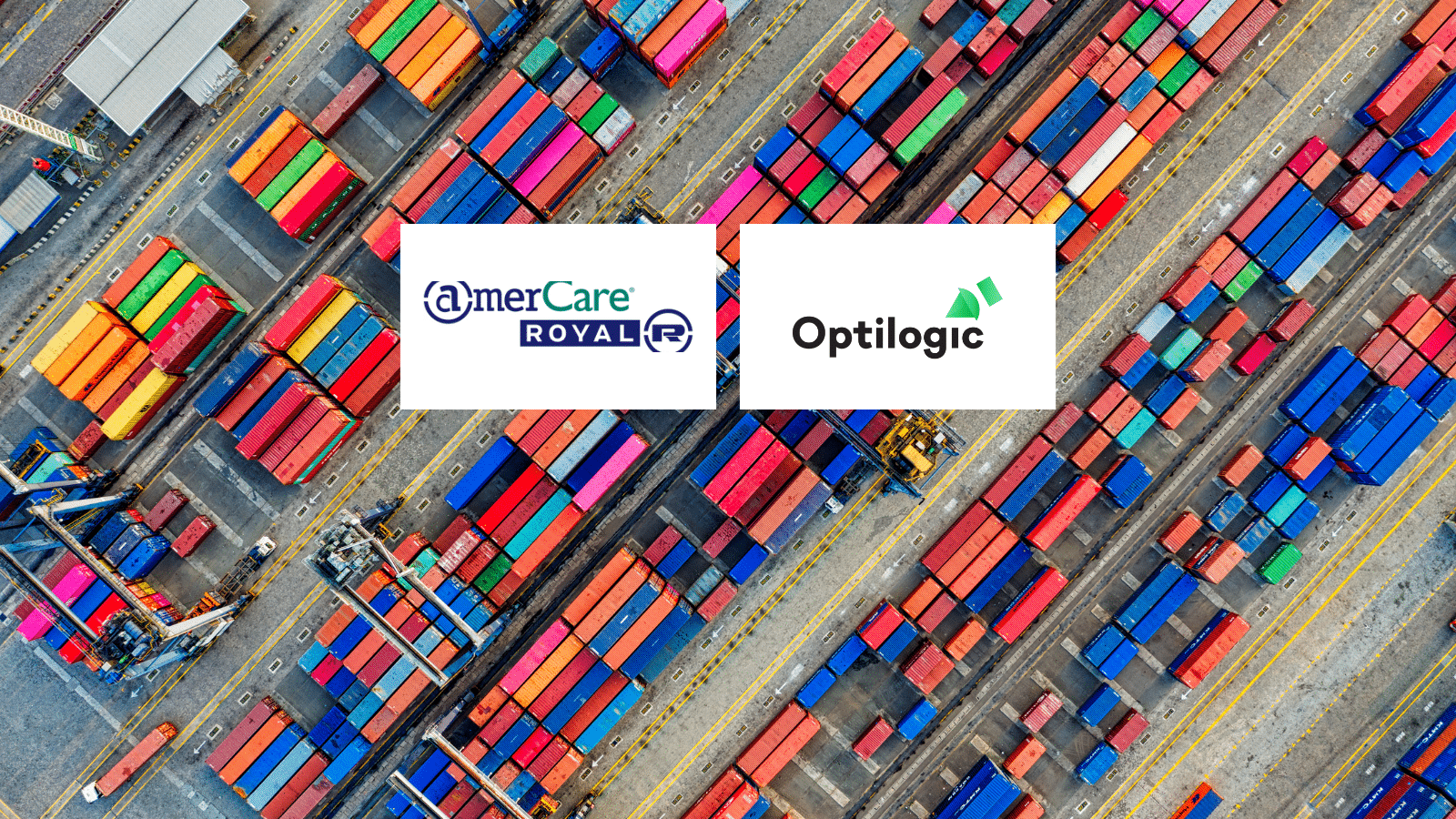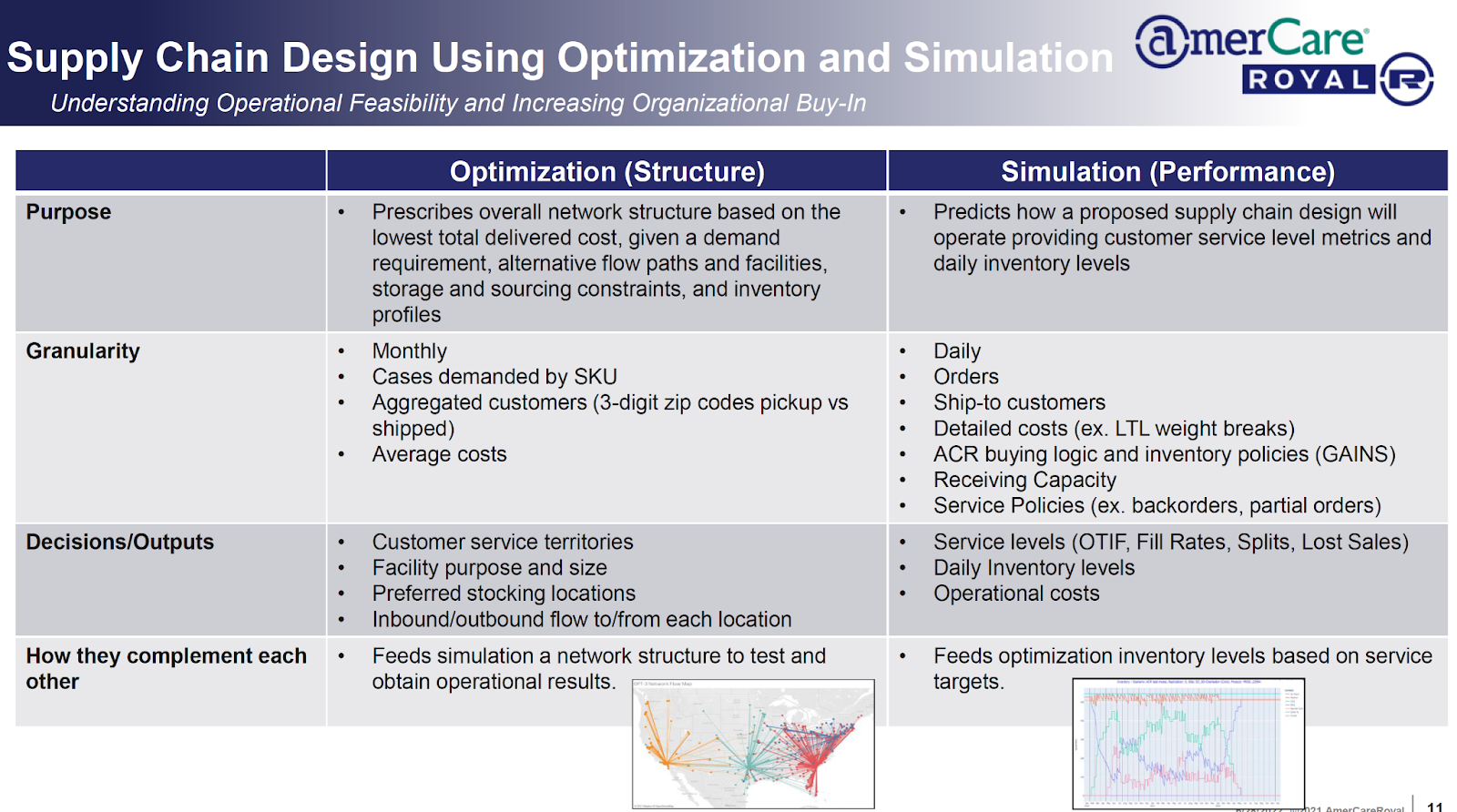
With Optilogic leading the way, AmerCareRoyal is overcoming growing pains and gaining a robust understanding of its complex, extended supply chain.
Published by
Published on
July 27, 2022





With a portfolio of 6,000+ SKUs, AmerCareRoyal is one of those companies that plays a role in the everyday lives of millions of people. Whether it’s drinking from a straw at Chipotle or the much-needed napkins at Buffalo Wild Wings, there’s a good chance that AmerCareRoyal’s supply chain was involved.
It’s not just for restaurants - AmerCareRoyal fulfills packaging and disposable goods as well as janitorial and sanitation supplies to a dizzying array of hospitals, supermarkets, convenience stores, big box stores, 500 plus food service clients throughout the United States, and the list goes on. All told, the company has around 25 product divisions that distribute goods (from source to end-user) and service the needs of more than 1,000 customers across 250 vendors.
“Complex” is an understatement when it comes to managing large, national clients that are supplied by an international supply base, but it was the company’s focus on smaller, founder-led, family-owned regional businesses that presented especially complicated challenges. The company had the goal to stitch these businesses together (in a sense) while also building out the brand as a kind of “one-stop-shop” for its customers. Achieving this goal required them to undergo some “growing pains,” says Brett Barnello, AmerCareRoyal’s Chief Supply Chain Officer.
“Over the last eight years, we’ve had significant volume growth in our business, but also a tremendous amount of growing pains in the sense that we went from one or two distribution centers to almost 25 distribution centers and 3PL locations,” he explains.
Barnello saw the potential benefits of making system wide network design improvements and partnered with Optilogic in 2020, embarking on what the company calls Project Rubik. The project’s mission, “to deliver a positive customer experience through our logistics network that supports our customer service goals at a value,” focused on improvements across six pain points:
“We had an overall lack of knowledge of our supply chain network. We really didn’t understand what our true cost drivers were…..where we were winning and losing. Our service implications weren’t really known. This was where the use of optimization and simulation allowed us to get a true understanding and to design our network towards our future growth ambitions.”- Brett Barnello, Chief Supply Chain Officer, AmerCareRoyal
At first, Barnello says his team was approaching operations from a siloed viewpoint, where they would tackle each function and work down a list. Service strategy, then customer service, then demand mapping and so on. In time, the strategy evolved to encompass a wider scope, where the team was considering how different functions worked together (and where overlaps in functions needed work).
“You need to understand order fulfillment, policies, product availability before you can really start to develop the supply chain strategy,” Barnello says. “How are we going to use our inventory and deployment? What’s our stocking strategy and replenishment? What do we need to do from a customer delivery perspective?” Each of these strategies works in tandem.
One of the first actions the Optilogic team took was to create a comprehensive baseline. This allowed Optilogic to wrap its hands around the stated challenges and to determine what key elements needed to be evaluated. The baseline included:
While AmerCareRoyal had not historically relied on optimization, the Optilogic team knew that optimization alone would only provide partial insights into a potential solution. A new approach that leaned on both optimization (structure) and simulation (performance) offered a more robust approach.

As Project Rubik evolved, Optilogic ran simulations on a multitude of scenarios, helping AmerCareRoyal reimagine concepts like buying logic, customer order routing, receiving operations, and transportation mode selection. Ultimately, 56 optimization and simulation runs provided granular insights into decisions that zeroed in on evaluating structures like hub-and-spoke, centralized, or a bi-coastal network that could best serve AmerCareRoyal in the short and long term.
Barnello points to several Optilogic-driven outcomes from Project Rubik.
By leveraging the Optilogic simulation capabilities in conjunction with optimization, we were able to gain important insights that impacted which supply chain strategy was selected for deployment. “Without bringing simulation into the process, we ran a very real risk of selecting a more costly design for AmerCareRoyal”.
Today, AmerCareRoyal’s strategy is “pragmatic,” says Barnello, “It will deliver achievable savings and improved service levels through the efficient deployment of our inventory working capital investment without significantly increasing our network footprint.”
Implementation work is underway, Barnello says. After just 12 weeks, AmerCareRoyal has seen gains in orders, lines, and cases and Barnello expects to see significant achievable savings in 2022, a remarkable accomplishment in such a volatile and uncertain period.
With a portfolio of 6,000+ SKUs, AmerCareRoyal is one of those companies that plays a role in the everyday lives of millions of people. Whether it’s drinking from a straw at Chipotle or the much-needed napkins at Buffalo Wild Wings, there’s a good chance that AmerCareRoyal’s supply chain was involved.
It’s not just for restaurants - AmerCareRoyal fulfills packaging and disposable goods as well as janitorial and sanitation supplies to a dizzying array of hospitals, supermarkets, convenience stores, big box stores, 500 plus food service clients throughout the United States, and the list goes on. All told, the company has around 25 product divisions that distribute goods (from source to end-user) and service the needs of more than 1,000 customers across 250 vendors.
“Complex” is an understatement when it comes to managing large, national clients that are supplied by an international supply base, but it was the company’s focus on smaller, founder-led, family-owned regional businesses that presented especially complicated challenges. The company had the goal to stitch these businesses together (in a sense) while also building out the brand as a kind of “one-stop-shop” for its customers. Achieving this goal required them to undergo some “growing pains,” says Brett Barnello, AmerCareRoyal’s Chief Supply Chain Officer.
“Over the last eight years, we’ve had significant volume growth in our business, but also a tremendous amount of growing pains in the sense that we went from one or two distribution centers to almost 25 distribution centers and 3PL locations,” he explains.
Barnello saw the potential benefits of making system wide network design improvements and partnered with Optilogic in 2020, embarking on what the company calls Project Rubik. The project’s mission, “to deliver a positive customer experience through our logistics network that supports our customer service goals at a value,” focused on improvements across six pain points:
“We had an overall lack of knowledge of our supply chain network. We really didn’t understand what our true cost drivers were…..where we were winning and losing. Our service implications weren’t really known. This was where the use of optimization and simulation allowed us to get a true understanding and to design our network towards our future growth ambitions.”- Brett Barnello, Chief Supply Chain Officer, AmerCareRoyal
At first, Barnello says his team was approaching operations from a siloed viewpoint, where they would tackle each function and work down a list. Service strategy, then customer service, then demand mapping and so on. In time, the strategy evolved to encompass a wider scope, where the team was considering how different functions worked together (and where overlaps in functions needed work).
“You need to understand order fulfillment, policies, product availability before you can really start to develop the supply chain strategy,” Barnello says. “How are we going to use our inventory and deployment? What’s our stocking strategy and replenishment? What do we need to do from a customer delivery perspective?” Each of these strategies works in tandem.
One of the first actions the Optilogic team took was to create a comprehensive baseline. This allowed Optilogic to wrap its hands around the stated challenges and to determine what key elements needed to be evaluated. The baseline included:
While AmerCareRoyal had not historically relied on optimization, the Optilogic team knew that optimization alone would only provide partial insights into a potential solution. A new approach that leaned on both optimization (structure) and simulation (performance) offered a more robust approach.

As Project Rubik evolved, Optilogic ran simulations on a multitude of scenarios, helping AmerCareRoyal reimagine concepts like buying logic, customer order routing, receiving operations, and transportation mode selection. Ultimately, 56 optimization and simulation runs provided granular insights into decisions that zeroed in on evaluating structures like hub-and-spoke, centralized, or a bi-coastal network that could best serve AmerCareRoyal in the short and long term.
Barnello points to several Optilogic-driven outcomes from Project Rubik.
By leveraging the Optilogic simulation capabilities in conjunction with optimization, we were able to gain important insights that impacted which supply chain strategy was selected for deployment. “Without bringing simulation into the process, we ran a very real risk of selecting a more costly design for AmerCareRoyal”.
Today, AmerCareRoyal’s strategy is “pragmatic,” says Barnello, “It will deliver achievable savings and improved service levels through the efficient deployment of our inventory working capital investment without significantly increasing our network footprint.”
Implementation work is underway, Barnello says. After just 12 weeks, AmerCareRoyal has seen gains in orders, lines, and cases and Barnello expects to see significant achievable savings in 2022, a remarkable accomplishment in such a volatile and uncertain period.
Fill out the form to unlock the full content

.png)

.png)